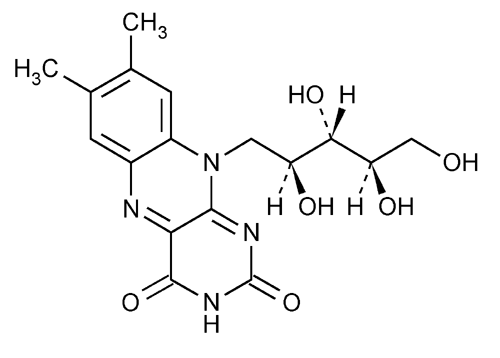Riboflavin
» Riboflavin contains not less than 98.0 percent and not more than 102.0 percent of C17H20N4O6, calculated on the dried basis.
Packaging and storage—
Preserve in tight, light-resistant containers.
Identification—
A solution of 1 mg in 100 mL of water is pale greenish yellow by transmitted light, and has an intense yellowish-green fluorescence that disappears upon the addition of mineral acids or alkalies.
Specific rotation  781S
781S :
between –115
:
between –115 and –135
and –135 .
.
Test solution:
5 mg per mL, in 0.05 M sodium hydroxide free from carbonate. Measure the specific rotation within 30 minutes of preparation.
Loss on drying  731
731 —
Dry about 500 mg at 105
—
Dry about 500 mg at 105 for 2 hours: it loses not more than 1.5% of its weight.
for 2 hours: it loses not more than 1.5% of its weight.
Residue on ignition  281
281 :
not more than 0.3%.
:
not more than 0.3%.
Limit of lumiflavin—
Prepare alcohol-free chloroform just prior to use, as follows. Shake 20 mL of chloroform gently but thoroughly with 20 mL of water for 3 minutes, draw off the chloroform layer, and wash twice more with 20-mL portions of water. Finally, filter the chloroform through a dry filter paper, shake it for 5 minutes with 5 g of powdered anhydrous sodium sulfate, allow the mixture to stand for 2 hours, and decant or filter the clear chloroform. Shake 25 mg of Riboflavin with 10 mL of the alcohol-free chloroform for 5 minutes, and filter: the absorbance of the filtrate, determined in 1-cm cells at a wavelength of 440 nm, with a suitable spectrophotometer, alcohol-free chloroform being used as the blank, does not exceed 0.025.
Assay—
[note—Conduct the entire procedure without exposure to direct sunlight.] Place about 50 mg of Riboflavin, accurately weighed, in a 1000-mL volumetric flask containing about 50 mL of water. Add 5 mL of 6 N acetic acid and sufficient water to make about 800 mL. Heat on a steam bath, protected from light, with frequent agitation until dissolved. Cool to about 25 , dilute with water to volume, and mix. Dilute this solution quantitatively and stepwise with water to bring it within the operating sensitivity of the fluorometer used. In the same manner, prepare a Standard solution to contain, in each mL, an accurately weighed quantity, of USP Riboflavin RS, equivalent to that of the Riboflavin solution prepared as directed above, and measure the intensity of its fluorescence in a fluorometer at about 530 nm. (An excitation wavelength of about 444 nm is preferable.) Immediately after the reading, add to the solution about 10 mg of sodium hydrosulfite, stirring with a glass rod until dissolved, and at once measure the fluorescence again. The difference between the two readings represents the intensity of the fluorescence due to the Standard. Similarly, measure the intensity of the fluorescence of the final solution of the Riboflavin being assayed at about 530 nm, before and after the addition of sodium hydrosulfite. Calculate the quantity, in µg per mL, of C17H20N4O6 in the final solution of Riboflavin taken by the formula:
, dilute with water to volume, and mix. Dilute this solution quantitatively and stepwise with water to bring it within the operating sensitivity of the fluorometer used. In the same manner, prepare a Standard solution to contain, in each mL, an accurately weighed quantity, of USP Riboflavin RS, equivalent to that of the Riboflavin solution prepared as directed above, and measure the intensity of its fluorescence in a fluorometer at about 530 nm. (An excitation wavelength of about 444 nm is preferable.) Immediately after the reading, add to the solution about 10 mg of sodium hydrosulfite, stirring with a glass rod until dissolved, and at once measure the fluorescence again. The difference between the two readings represents the intensity of the fluorescence due to the Standard. Similarly, measure the intensity of the fluorescence of the final solution of the Riboflavin being assayed at about 530 nm, before and after the addition of sodium hydrosulfite. Calculate the quantity, in µg per mL, of C17H20N4O6 in the final solution of Riboflavin taken by the formula:
C(IU / IS)
in which C is the concentration, in µg per mL, of USP Riboflavin RS in the final solution of the Standard, and IU and IS are the corrected fluorescence values observed for the solutions of the Riboflavin and Standard, respectively.
Auxiliary Information—
Please check for your question in the FAQs before contacting USP.
Chromatographic Column—
| Topic/Question | Contact | Expert Committee |
| Monograph | Curtis Phinney
1-301-816-8540 |
(DSN05) Dietary Supplements - Non-Botanicals |
| Reference Standards | Lili Wang, Technical Services Scientist 1-301-816-8129 RSTech@usp.org |
USP32–NF27 Page 3497
Pharmacopeial Forum: Volume No. 30(3) Page 929
Chromatographic columns text is not derived from, and not part of, USP 32 or NF 27.
